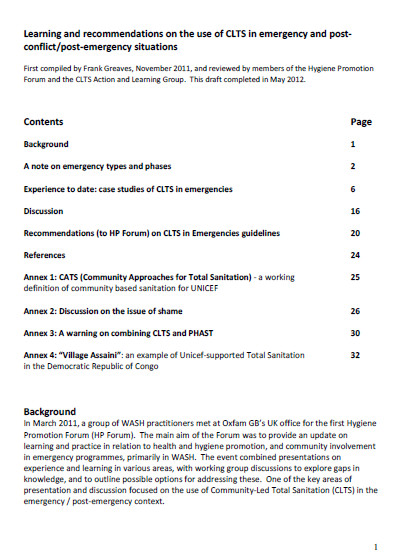Learning and recommendations on the use of CLTS in emergency contexts
 |
rapport Jun 2012 ; 33 pages
Aut. Frank Greaves
Ed. Tearfund - Teddington
Téléchargeable sous format: PdF
Téléchargeable chez l'éditeur
Abstract:
In recent times there has been a growing interest in the use of CLTS in emergency, post-emergency and post-conflict situations, and in Fragile States. Indeed, some agencies have seen particular success in these arenas, at least in the early stages, e.g. Tearfund in Afghanistan and in DRC. However, there are also perceptions that CLTS is fundamentally “mis-matched” to achieving safe sanitation at scale in an emergency, or immediate post-emergency, context. Two primary reasons for this include its core principle that sanitation hardware should not be subsidized if replication to scale and long-term sustainability of improved sanitation is to be realized: how is CLTS practically workable in a situation where participants have often lost all their wealth, and are at the point of greatest dependency on the aid community for their well-being? A second issue is that of “inclusivity”: can the poorest sections of the population obtain facilities for safe sanitation when their community structure and its social capital have been devastated?
Mots clefs: |
assainissement autonome (CI) (DT) (OP) (ope) , ATPC Assainissement Total Piloté par la Communauté (CI) (DT) (OP) (ope) |
Editeur/Diffuseur: |
|
Tearfund - Teddington - Royaume Uni |
En cas de lien brisé, nous le mentionner à communication@pseau.org